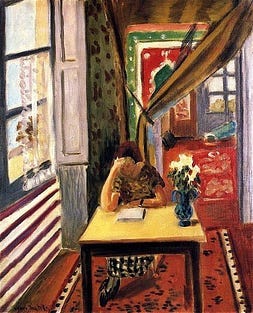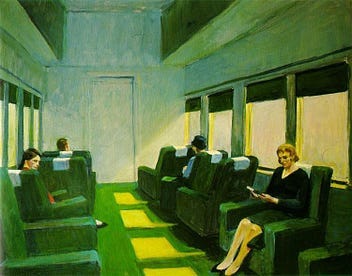#96 - Is Slow Reading Officially a Trend?
Reading the Room; Concrete Floors and Stuff in Drawers; Michael’s Boochies
Hello, my friends,
Not to be a downer, but my arm hurts. I’m not sure how it happened but it seems that I’ve strained a tendon or a ligament in my left elbow and it has been painful and uncomfortable in every position for the past week. I went to urgent care during my lunch break a couple of days ago and the doctor prescribed me a high dose of Ibuprofen and strongly urged me to take it three times a day for ten days. “…Not four days, not six days, he said, some people stop taking it because they think it’s not working. Take it for ten days because that’s how long it takes for the thing to do its things.” Hopefully Dr. Kim is right. We’ll all find out around the 13th, if not earlier.
Reading the Room
I don’t know what the exact criteria for calling some pattern of activity a trend is but for me, if I see related signals from multiple unrelated sources that tells me that a phenomena is percolating in the milieu. Lately, I have noticed that reading classic texts is having a moment. Throughout this year, Florian over at Practical Polymath has been reading and responding in writing to timeless works like Steinbeck’s East of Eden, the Iliad and Odyssey, Hermann Hesse’s Siddartha (a personal favorite), and others. In a link a picked up from other parts of the web (hacker news) was Waqas Younas’s reflections on reading classics by Cicero, Aeschylus, and Steven Martin at Thoughts of an imprint. And, of course, if you’re a reader on Substack, you’ve probably come across Ted Gioia’s Lifetime Reading Plan, which basically says, in a surprising twist, that to become “well read” you need to spend decades with a lot of interesting and challenging books.
I’m not sure this is a trend exactly because sharing book notes has been a thing among folks I respect for a long time. What I’m seeing, though, is more people breaking past a currency bias and reading books beyond that hottest titles of the last twenty years. Further, they are reading them slowly and carefully. This is also counter to the competitive vibe of people vying for most books read; it doesn’t matter whether someone has read ten or ninety books this year if they weren’t meaningful. And why read what has endured? Perhaps in our increasingly fragmented world, people feel drawn to the stability of a canon that has persisted for hundreds of years. Might there be a reason that Beowulf remains on reading lists besides to glorify feasting and frustrate undergraduates?
In the same wind of questioning, could this be that I’m simply curating my inputs in a way that I’m more likely than most to see signals of people looking cool reading classics? I was at a hip coffee shop in my neighborhood on a recent morning and there was a very stylish man sitting at the bar sipping his coffee and reading a book. I don’t see that often at Coffee Bean, possibly because I rarely go there.
This trend may have an economic component as well because it seems that the resurgence of Barnes & Noble is also a hot topic as of late. This, however, is not news to me since even movie city Los Angeles is littered with book shops. As proof, I have probably 15 bookstores within a 20-minute drive of where I currently sit. I believe that the death knell for books and reading may actually be wedding bells.
Concrete Floors and Stuff in Drawers
I’m not a very able decorator, but I have strong opinions about what I like and dislike. For instance, what’s the deal with concrete floors and super high ceilings? If I wanted to live at a warehouse, I would work for Amazon. But there, you have people who change the light bulbs when they go out. If I had 20-foot high ceilings, I’d need to rent a giant ladder and move my furniture every time a light went out. You know what concrete floors and high ceilings would be okay for? Karaoke night! Thick floors and lots of space would mean the neighbors wouldn’t be as bothered when I tried to sing “Colors of the Wind”.
Another interior design question I have: Where does the all the stuff go? I look at photos of interior design in magazines and online and these people must be uber-minimalists because there place is totally devoid of regular living utensils. Sure, they probably put it away for the photo shoot, but to me that’s dishonest; interior decoration is meant for living, isn’t it? How am I supposed to make a proper evaluation of the design if I can’t tell whether the aesthetics would win a battle with everyday clutter. That’s why I enjoy the photos (and interviews) from LIFECYCLING. These people are stylish and don’t put all their stuff in a big pile in the other room for the photoshoot.
Speaking of stuff. Why do interior design pics have so many chairs? How many people are coming to this house that they need a couch and like 75 chairs in their living room? They’re just cappin’ because no one needs so many chairs. Actually, that’s not true. In our late teens, my brother and I worked a few times as bartenders and servers during parties at a private residence of a wealthy man in Beverly Hills. He would hire a klezmer band for his shindigs and there were a lot of guests. Whatever extra chairs he had hanging around would all be used during those evenings. Thankfully, they didn’t look like the ones in this SNL skit.
For designs I do like, see my are.na channel, which is aptly named “rooms i like”.
Michael’s MoochiesBoochies
Michael (age 5) draws various characters that I really enjoy seeing. Sometimes he calls them Moochies, sometimes Boochies, and when he’s feeling scatological (often), he calls the poochies and then goes off about poop. Anyway, let’s welcome the new year with Moochies:











Thought you'd like the initiative we're pursuing for incentivizing the reading of classics - Classics Buttons! https://www.relib.net/content/classics-buttons
We've given over 1400 of them out in three years - and we're a small rural system!